 Lehigh students appear to be largely avoiding this season’s strain of the flu, despite high rates in Pennsylvania and within Northampton County.
Lehigh students appear to be largely avoiding this season’s strain of the flu, despite high rates in Pennsylvania and within Northampton County.
Only six Lehigh students have been diagnosed with the flu during the 2018-2019 flu season, the Lehigh Health and Wellness Center said. According to the CDC, flu season occurs from October to May and spikes from December to February.
These numbers fall short of the previous season’s figures. In the first two months of 2018, 45 Lehigh students were diagnosed with the flu — in line with the state’s worst flu season on record. By the end of the flu season, more than 122,000 flu-related infections and around 260 flu-related deaths were reported statewide, said Nate Wardle, a spokesman for the Pennsylvania Department of Health.
This season’s most prominent strain, an influenza A H1N1-type, is not as severe as last year’s. However, Northampton County has the fifth highest flu severity rate of Pennsylvania’s 67 counties.
County-wide, 1,806 cases of influenza A and 64 of influenza B have been recorded as of Feb. 16. Statewide, 47 flu deaths have been reported.
Bethlehem has reported around 130 cases of influenza A and two of influenza B as of Jan. 31, said Stephanie Oakley of the Bethlehem Health Bureau. However, she cautioned that such figures are underestimates.
“Diagnosing (the) flu in this country is often a clinical diagnosis, and far more patients will come down with the flu than will be tested,” said Thomas Novak, the interim director of the Health and Wellness Center, in an email.
Novak said the same is true for university students. Given that students are constantly in close proximity to one another, a greater chance of disease transmission persists at universities. However, the Health and Wellness Center said more than 800 flu vaccines were administered in the fall semester.
Around 500 of those vaccinations occurred at an Oct. 18 event, where local Walgreens clinics provided vaccines to Lehigh students in Lamberton Hall.
The vaccine administered by residential health practitioners contains both strains, Oakley said.
“(Most) vaccines are usually 80-90 percent effective,” she said.
Wardle said still unvaccinated individuals, particularly in high-risk areas like Northampton County, should pursue vaccination. He said vaccines usually have a two-week gestation period for immunity.
“Living in close quarters and activities that promote the spread of germs — kissing, sharing food and drinks, infrequent handwashing — are factors that often allow for the spread of flu and other infections on college campuses,” Novak said.
This year’s virus originated uncharacteristically in eastern Pennsylvania, moving westward, as opposed to its normal eastern trajectory, Wardle said. He said he had no information available to explain this phenomenon.





Comment policy
Comments posted to The Brown and White website are reviewed by a moderator before being approved. Incendiary speech or harassing language, including comments targeted at individuals, may be deemed unacceptable and not published. Spam and other soliciting will also be declined.
The Brown and White also reserves the right to not publish entirely anonymous comments.